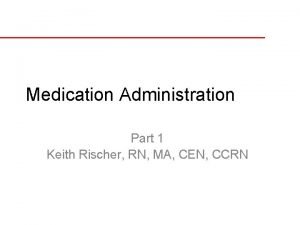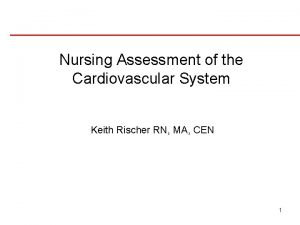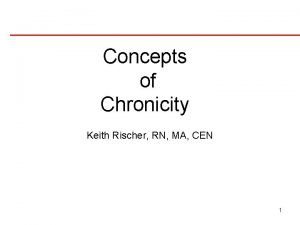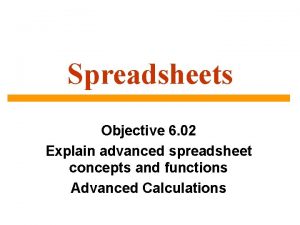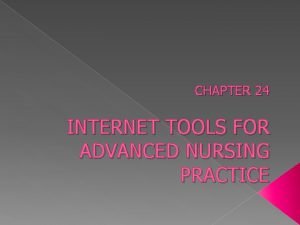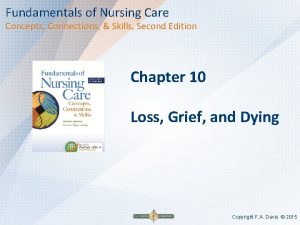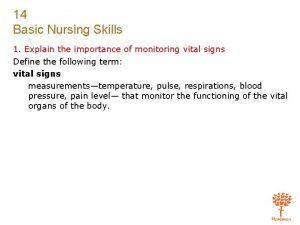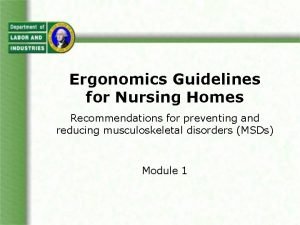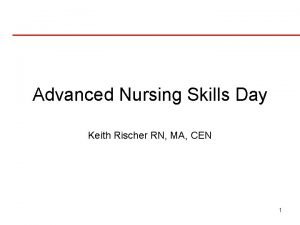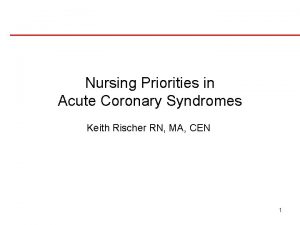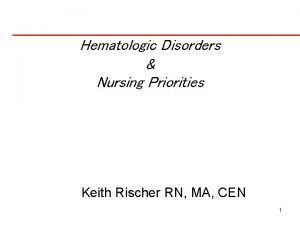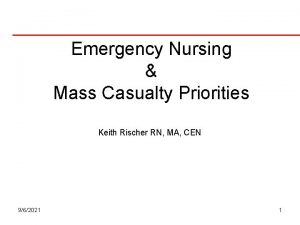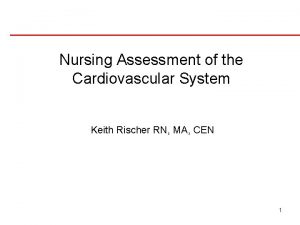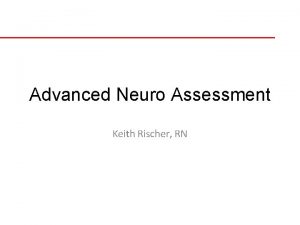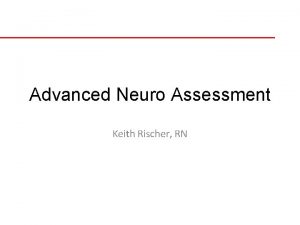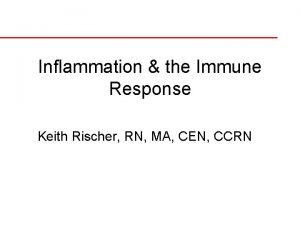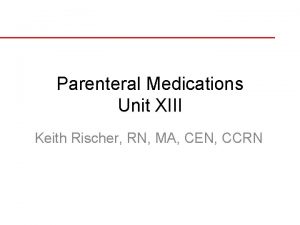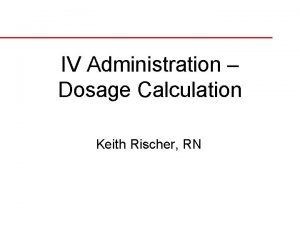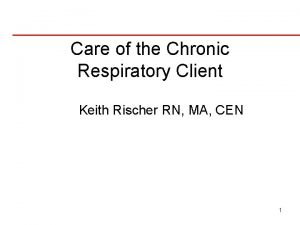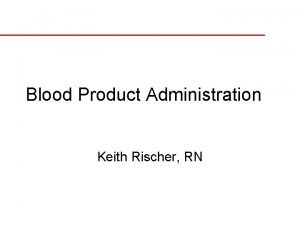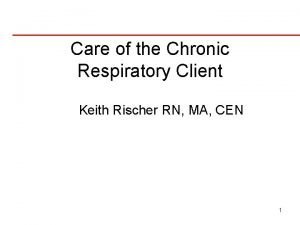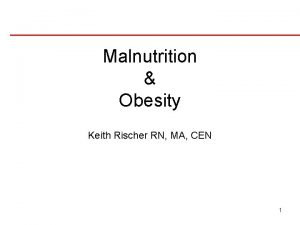Advanced Nursing Skills Day Keith Rischer RN MA






































- Slides: 38

Advanced Nursing Skills Day Keith Rischer RN, MA, CEN 1

Today’s Objectives… IV Meds Ø In a simulated clinical situation, demonstrate hanging an IV piggyback and calculate correct rate and set up on Horizon pump. Ø In a simulated clinical situation, demonstrate calculation to safely administer IV medication bolus per PDA and administer. Ø In a simulated clinical situation, calculate correct dose of Heparin bolus and drip rate per SCH policy and protocol. Carb Counting-Insulin Ø In a simulated clinical situation, calculate the correct dose of insulin to administer based on CHO intake at meal. Ø In a simulated clinical situation, based on sliding scale calculate the correct dose to administer and demonstrate correct technique to mix Regular and NPH or Lente. Ø Demonstrate correct technique to administer insulin via insulin pen. 2

Today’s Objectives… IV Insertion Ø State the veins of the hands and arms that could be used for intravenous insertion for all ages. Ø Implement measures to promote venous distention. Ø State potential complications when initiating IV therapy and measures to prevent complications. Ø Demonstrate IV insertion, dressing of the IV site and application of a saline lock safely with the simulation arm. Central-Arterial Lines Ø Identify indications for placement of central/arterial lines. Ø Identify significance of CVP and normal ranges Ø Describe nursing responsibilities and priorities for the client with central/arterial lines. Ø State potential complications and measures to prevent complications with central/arterial lines. 3

Today’s Objectives… Chest Tubes Ø Identify indications for placement of chest tubes. Ø Describe the principles and patho that support the use of chest tubes. Ø Describe nursing responsibilities and priorities for the client with chest tubes. Ø Identify significance of bubbling in the waterseal chamber and what assessments are required by nurse. ET-Ventilator Ø Identify indications for placement of endotracheal tube/ventilator. Ø Describe nursing responsibilities and priorities for the client during intubation with ventilator. Ø Identify principles of ABG interpretation and relevance to ventilator management. Ø Describe different modes of ventilation and significance of ventilator settings. Ø State potential complications and measures to prevent complications with ventilator. 4

Insulin & Carb Counting Ø Time action profiles of… • • Novolog Regular Lente NPH Mixing Ø Insulin pen Ø 5

IV Med Administration Principles COMPATIBILITY Ø Correctly calculate rate of IV push to q 1530 seconds Ø Label all syringes brought into room once aspirated Ø Assess site Ø Aseptic technique w/port Ø Knowledge of most common side effects Ø 6

IV Meds Ø IV Push • • Ø IV Piggyback • • Ø Morphine 4 mg/1 cc PDA 1 mg per minute…how much volume q minute Rocephin 1 Gram in 50 cc bag Give over 30”-what do you set IV pump to infuse IV Heparin • • 215 lbs. 70 u/kg bolus…. 15 u/kg hourly rate 7

SAVE that Line! ØS: Scrupulous hand hygiene • Before and after contact w/vascular access device and prior to insertion ØA: Aseptic technique • During catheter insertion & care ØV: Vigorous friction to hubs • With alcohol whenever you make or break a connection to give meds, flush ØE: Ensure patency • Flush all lumens w/adequate amount of saline or heparin to maintain patency per hospital policy 8

IV Insertion: Venous Selection Ø Start distally • Ø Ø Ø LE not routinely used in adults due to risk of embolism/thromboplebitis Visualize veins if possible Avoid areas of flexion Use smallest IV possible • • 22 ga. (blue) Standard Ensure vein can handle size of jelco 9

Principles of IV Therapy BP cuff-keep on opposite arm if continuous IV infusion Ø Do not use PIV same side as pt. who has had axillary node dissection, dialysis shunt Ø Hair removal if needed-use clippers or scissors Ø 10

IV Insertion 1. 2. 3. 4. 5. 6. 7. 8. Chloroprep 1. Prep for at least 10 seconds 2. Allow to air dry before insertion Distal/circumferential traction Low approach angle…bevel up directly on top of vein Upon blood flash go level and advance 1/8” Slide jelco in slowly Pressure on vein 1” distally once removed stylette Stabilize PIV securely with tape or Stat-lock if available (preferred) Transparent dressing 11

IV Therapy Complications: Infiltration Ø Progression • • Skin blanched…edema<1” in any direction…cool to touch…may or may not have pain Edema 1 -6” in any direction ü • • At this level or greater requires incident report Gross edema >6” in any direction…mild to moderate pain Skin tight, leaking, discolored, bruised or swollen, deep pitting edema, circulatory impairment 12

Infiltration/Extravasation: Nursing Priorities Ø Ø DC infusion immediately Document…notify MD Ongoing assessment of CMS and appearance Follow guidelines depending on if vesicant medication • Ø Dopamine & vasopressors most common Extravasation injuries are a sentinel event 13

IV Therapy Complications: Phlebitis Ø Progression • • Initially redness at site with or without pain Pain at access site w/redness In addition red streak…palpable venous cord Palpable venous cord >1” and purulent drainage At first sign of phlebitis IV must be DC’d and event documented 14

IV Therapy Complications 15

IV Therapy Complications: Infection Ø Prevention • • Ø Use aseptic technique when accessing ports and upon insertion Monitor site and integrity of dressing Infection Present • • Blood cultures from catheter and separate venous site Monitor for sepsis 16

Site Assessment • • • Assess tenderness by palpation Redness Moisture/leaking Swelling distally if continous infusion Dressing labeled ü Date inserted ü Size of IV jelco ü Initials of nurse • If >4 days since inserted DC and restart 17

Nursing Responsibilities Ø Ø Frequent IV site assessment Be aware of medications that irritate vein Vigilant with meds that can cause cellular damage if infiltrate Infiltrated? • • Stop IV immediately Elevate extremity Warm packs Check w/pharmacy if additional measures needed 18

Nursing Responsibilities Ø Primary/secondary tubing changed per hospital policy • • Q 4 days (ANW) TPN/Lipids changed q day Intermittent IVPB tubing changed q 24 hours Ø When IV dc’d assess site and make sure jelco tip intact Ø If Heparin used to flush central access device…assess for HIT Ø 19

PIV Troubleshooting Ø Pain • Ø Distal occlusion alarm on IV pump • • Ø AC site-extend arm Flush site and assess for occlusion Leakage • Ø Assess site…always a red flag and IV should be DC’d unless has irritating solution infusing Make sure is not from loose attachment to jelco ? Infiltration • • Flush IV slowly w/5 -10 cc NS Assess for leakage/swelling/pain 20

Central Lines: PICC Ø Indications • Ø Length of therapy Complications • Phlebitis ü Ø Measure mid arm circimference and document Nursing Priorities • • • Dressing intact Site assessment Note how many cm. out to hub & validate 21

Central Lines: Implanted Port 22

Central Lines: Implanted Port Accessing ports Ø Access needle/tubing changed q 7 days Ø Dressing changed q 7 days Ø Site assessment Ø 23

Central Lines: Non-Tunneled Ø Indications • Ø Ø Length of therapy Complications Nursing Priorities • Risk of Infection Insertion ü Accessing device ü Systemic infection ü Remove as soon as possible ü 24

Arterial Lines Ø Ø Ø Locations Indications Nursing priorities • • Site care Pressure bag CMS Complications Infection ü Infiltration ü Bleeding ü 25

Blood Product Administration Minimum 22 g. (blue hub) IV-prefer 20 g. (pink) or 18 g. (green) Ø Informed consent obtained Ø Administer within 30” once received from Blood Bank Ø Blood tubing with filter-use NS to prime/flush Ø • • Validate pt. , type of blood product, expiration date, blood tag # VS before, 15” after initiation, end of each Infuse PRBC’s over 2 hours (appx 300 cc/unit) Consider Lasix chaser if hx CHF 26

Complications Blood Products Ø Circulatory Overload Acute Hemolytic Reaction • Chills, fever, flushing, tachycardia, SOB, hypotension, acute renal failure, shock, cardiac arrest, death Febrile-Nonhemolytic Reaction • Sudden onset of chills, fever, temp elevation >1 degree C. headache, anxiety Mild Allergic Reaction • Flushing, urticaria, hives 27

Nursing Responsibilities STOP transfusion Ø Maintain IV site-disconnect from IV and flush with NS Ø Notify blood bank/MD Ø Recheck ID Ø Monitor VS Ø Treat sx per MD orders Ø Save bag and tubing-send to blood bank Ø 28

Chest Tube: Nursing Priorities Ø Ø Assess resp. status closely Check water seal for bubbling Milk NOT strip every 2 hours Assess color-amount drainage • Ø Call MD if >100 cc/hr x 2 hours first 24 hours Sterile quaze/occlusive dressing at bedside 29

Mechanical Ventilation Ø Ø The use of an ET and POSITIVE pressure to deliver O 2 at preset tidal volume Modes • Assist Control (AC) ü ü • Synchronized Intermittent Mandatory Ventilation (SIMV) ü ü • • TV & rate preset Additional resp. receive preset TV Additional resp. receive own TV Used for weaning Continuous Positive Airway Pressure (CPAP) Bi-pap ü ü Non-mechanical receive both insp. & exp. Pressures w/facemask 30

Mechanical Ventilation Ø Terminology • • Rate Tidal volume ü • Fraction of inspired O 2 concentration (Fi. O 2) ü • • Use lowest possible to maintain O 2 sats Positive End Expiratory Pressure (PEEP) Minute volume ü Ø 10 -15 cc/kg RR x TV AC 12 -TV 600 -50%-+5 31

Mechanical Ventilation: Adverse Effects Ø Complications • • • Aspiration Infection-VAP Stress ulcer of GI tract Tracheal damage Ventilator dependancy Decreased cardiac output ü • Positive pressure decr. venous return & CO Barotrauma ü pneumothorax 32

Mechanical Ventilation: Nursing Priorities Ø Ø Ø Monitor VS-breath sounds closely Assess ET securement/length at lip Clearance of secretions • • • Ø Sedation • Ø Ø Closed suction-maintains sterility Do not do routinely Pre-oxygenate Propofol Oral care Nutritional support 33

Mechanical Ventilation: Nursing Priorities Ø Ventilator Alarm Troubleshooting • High pressure ü Secretions-needs sx ü Tubing obstructed or kinked ü Biting ET • Low pressure ü Disconnection of tubing ü Follow tubing from ET to ventilator 34

Arterial Blood Gases: Ventilator Case Study Ø Ø 40 yr male w/seizure disorder Chief complaint • • Ø Physical assessment • Ø Altered mental status Vague abd pain Weakness Hypotension Epigastric-LUQ tender VS • T-101. 2/P-110/R-24/BP 92/42/sats 95% RA Ø Admission Labs • • • WBC-11, 000 Hgb-12. 2 Platelets-64, 000 Creatinine-2. 7 ALT-502 AST-219 Ammonia-68 Lipase-1947 Glucose-322 CT-encephalopathy Abd CT-inflamm. pancreas 35

Case Study: Later… Day of Admission Increasing lethargy, resp. distress Ø ABG Ø • • p. H- 7. 28 CO 2 - 59 O 2 - 52 HCO 3 - 23 O 2 sats- 84 Fi. O 2 -100% vent…AC 12, PEEP +5 CT-abd. Ileus-hepatic infarcts 36

Case Study: Day 1 Ø Ø CVP-21 VS-101. 2 -118 -24 -82/40 NG placed Labs • • WBC-12. 7 Platelets-56 Creatinine-. 7 ALT-243 AST-219 Lipase 523 ABG ü ü ü p. H-7. 25 CO 2 -52 O 2 -76 O 2 sats-92% Fi. O 2 -100% PEEP now +10 Ø Ø Ø Weight up 8 kg Non icteric IV Infusions • • • Insulin gtt Lasix gtt TPN-Lipids Fentanyl gtt Versed gtt Levophed gtt Neosynephrine gtt Vasopressin gtt Heparin gtt 37

Case Study: Day 2 Ø Ø Ø CVP-16 –weight up another 7. 5 kg…poor u/o VS-100. 5 -110 -24 -84/44 Labs • • • WBC-21. 5 Hgb-12. 5 Platelets-77 Creatinine-0. 9 ALT-143 AST-41 Ammonia-30 Lipase 114 CXR-white out ABG ü ü ü p. H-7. 11 CO 2 -78 O 2 -58 HCO 3 -24 O 2 sats-75% Vent-Fi. O 2 -100%, +15 Ø Treatment Plan • • Ø CRRT IV abx-Cipro/Flagyl Hold Lasix gtt NG LCS Lactulose Wean vasoactive gtts as able Continue all previous gtts Pan cultures Physical assessment • Distended abd-hypoactive ü • • NG bile output Coarse crackles bilat Cool to touch Nursing Priorities… 38
 Keith rischer
Keith rischer Keith rischer
Keith rischer All people enjoy time magazine
All people enjoy time magazine Keith rischer
Keith rischer Day 1 day 2 day 3 day 4
Day 1 day 2 day 3 day 4 Day 1 day 2 day 817
Day 1 day 2 day 817 Spreadsheet concepts
Spreadsheet concepts Edunet south africa
Edunet south africa Advanced skills of persuasive writing
Advanced skills of persuasive writing Internet tools for advanced nursing practice
Internet tools for advanced nursing practice Intrapersonal skills examples
Intrapersonal skills examples Soft skills это
Soft skills это Skills passport
Skills passport William beanes elementary school
William beanes elementary school Ocean the part day after day
Ocean the part day after day Day to day maintenance
Day to day maintenance Physical science chapter 6 review answers
Physical science chapter 6 review answers I don't know about tomorrow i just live from day to day
I don't know about tomorrow i just live from day to day Romeo and juliet week timeline
Romeo and juliet week timeline Growing day by day
Growing day by day Observation of seed germination day by day
Observation of seed germination day by day Day by day seed germination observation chart
Day by day seed germination observation chart Seeds vs spores
Seeds vs spores I live for jesus day after day
I live for jesus day after day Oh glorious day
Oh glorious day Day one day one noodle ss2
Day one day one noodle ss2 Dayone ss2
Dayone ss2 Fundamentals of nursing care concepts connections & skills
Fundamentals of nursing care concepts connections & skills Chapter 14 basic nursing skills
Chapter 14 basic nursing skills Chapter 14 basic nursing skills
Chapter 14 basic nursing skills Nursing homes day out an
Nursing homes day out an Nursing homes day out an
Nursing homes day out an Team nursing model advantages and disadvantages
Team nursing model advantages and disadvantages Care plan for ocd patient
Care plan for ocd patient Preoperative nursing care plan for cataract surgery
Preoperative nursing care plan for cataract surgery Nursing process introduction
Nursing process introduction Nursing process in psychiatric nursing
Nursing process in psychiatric nursing Keith mukami
Keith mukami Keith and shuttleworth gender theory
Keith and shuttleworth gender theory
